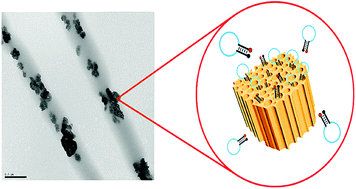Our official English website, www.x-mol.net, welcomes your
feedback! (Note: you will need to create a separate account there.)
Hybrid polymer/porous silicon nanofibers for loading and sustained release of synthetic DNA-based responsive devices.
Nanoscale ( IF 5.8 ) Pub Date : 2020-01-13 , DOI: 10.1039/c9nr08474f Jonathan M Zuidema 1 , Alessandro Bertucci 2 , Jinyoung Kang 3 , Michael J Sailor 4 , Francesco Ricci 5
Nanoscale ( IF 5.8 ) Pub Date : 2020-01-13 , DOI: 10.1039/c9nr08474f Jonathan M Zuidema 1 , Alessandro Bertucci 2 , Jinyoung Kang 3 , Michael J Sailor 4 , Francesco Ricci 5
Affiliation

|
Synthetic DNA-based oligonucleotides are loaded into porous silicon nanoparticles (pSiNPs) and incorporated into nanofibers of poly(lactide-co-glycolide) (PLGA), poly-l-lactic acid (PLA), or polycaprolactone (PCL). The resulting hybrid nanofibers are characterized for their ability to release the functional oligonucleotide payload under physiologic conditions. Under temperature and pH conditions mimicking physiological values, the PLGA-based nanofibers release >80% of their DNA cargo within 5 days, whereas the PLA and PCL-based fibers require 15 days to release >80% of their cargo. The quantity of DNA released scales with the quantity of DNA-loaded pSiNPs embedded in the nanofibers; mass loadings of between 2.4 and 9.1% (based on mass of DNA-pSiNP construct relative to mass of polymer composite) are investigated. When a responsive DNA-based nanodevice (i.e. molecular beacon) is used as a payload, it retains its functionality during the release period, independent of the polymer used for the formation of the nanofibers.
中文翻译:

杂化聚合物/多孔硅纳米纤维,用于加载和持续释放合成的基于DNA的响应设备。
将基于合成DNA的寡核苷酸装载到多孔硅纳米颗粒(pSiNPs)中,并掺入聚(丙交酯-共-乙交酯)(PLGA),聚-1-乳酸(PLA)或聚己内酯(PCL)的纳米纤维中。所得杂化纳米纤维的特征在于它们在生理条件下释放功能性寡核苷酸有效载荷的能力。在模拟生理值的温度和pH条件下,基于PLGA的纳米纤维在5天内释放超过80%的DNA货物,而基于PLA和PCL的纤维需要15天释放超过80%的货物。DNA释放的数量与纳米纤维中嵌入的DNA负载的pSiNP的数量成比例。研究了在2.4%到9.1%之间的质量负载(基于DNA-pSiNP构建体的质量相对于聚合物复合材料的质量)。
更新日期:2020-01-13
中文翻译:

杂化聚合物/多孔硅纳米纤维,用于加载和持续释放合成的基于DNA的响应设备。
将基于合成DNA的寡核苷酸装载到多孔硅纳米颗粒(pSiNPs)中,并掺入聚(丙交酯-共-乙交酯)(PLGA),聚-1-乳酸(PLA)或聚己内酯(PCL)的纳米纤维中。所得杂化纳米纤维的特征在于它们在生理条件下释放功能性寡核苷酸有效载荷的能力。在模拟生理值的温度和pH条件下,基于PLGA的纳米纤维在5天内释放超过80%的DNA货物,而基于PLA和PCL的纤维需要15天释放超过80%的货物。DNA释放的数量与纳米纤维中嵌入的DNA负载的pSiNP的数量成比例。研究了在2.4%到9.1%之间的质量负载(基于DNA-pSiNP构建体的质量相对于聚合物复合材料的质量)。











































 京公网安备 11010802027423号
京公网安备 11010802027423号